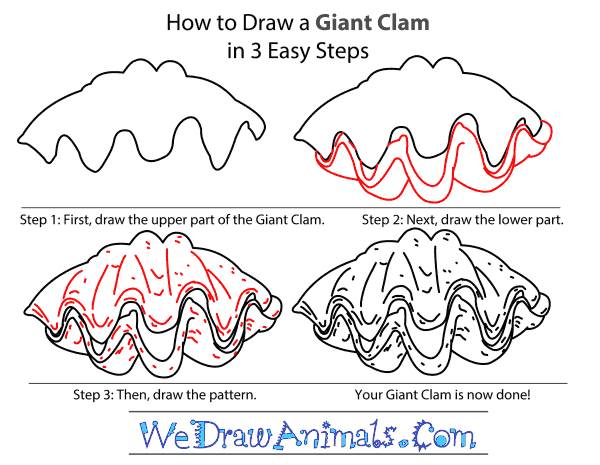In this quick tutorial you'll learn how to draw a Giant Clam in 3 easy steps - great for kids and novice artists.
The images above represent how your finished drawing is going to look and the steps involved.
Below are the individual steps - you can click on each one for a High Resolution printable PDF version.
At the bottom you can read some interesting facts about the Giant Clam.
Make sure you also check out any of the hundreds of drawing tutorials grouped by category.
How to Draw a Giant Clam - Step-by-Step Tutorial
Step 1: First, draw the top part of the opening in the Giant Clam’s shell using wavy lines. Draw a rough and uneven triangular shape to complete the top edge of the shell as shown in the image.
Step 2: Next, let us draw the lower part of the shell using wavy lines just like the previous step. Draw the lower edge of the shell opening and add a second line near it to complete the Giant Clam’s shell. Make the lower part of the shell smaller than the upper part and leave a tiny gap between the two parts to make the shell look like it is open.
Step 3: Add slanting lines to show the groove patterns of the Giant Clam’s shell. Use small curved dashes and small dots to show the patterns of the shell. Now that your Giant Clam drawing is complete, you can start coloring it.
Interesting Facts about Giant Clams
Giant Clams are creatures right out of fairy tales and cartoons. They stay in 1 place their whole lives and wait for food to come to them. A Giant Clam is actually a smaller animal that uses the huge shell for protection. This huge clam is found on coral reefs in the Indian and South Pacific Oceans. They eat plants like algae and food left over from other fish swimming by it. A Giant Clam is 35 to 47 inches long and weighs over 225 pounds! The shell colors come in beautiful shades of blue, red, yellow, green, and even pink!
Did you know?
- There are 100 species of Giant Clam.
- Giant Clams are Bivalves, which means they live in a 2 part shell.
- Giant Clams have both male and female parts. However, they can’t mate on their own. They have to have the eggs and sperm from another Giant Clam to reproduce.
- Giant Clams are vulnerable to extinction because they a popular food in some places.
- Giant Clams can live for 100 years!
Activity: Draw a picture of a Giant Clam. Set out crayons, markers, colored pencils, and maybe glitter and glue. Distribute the drawing to each student and ask them to color the prettiest Giant Clam they can.




